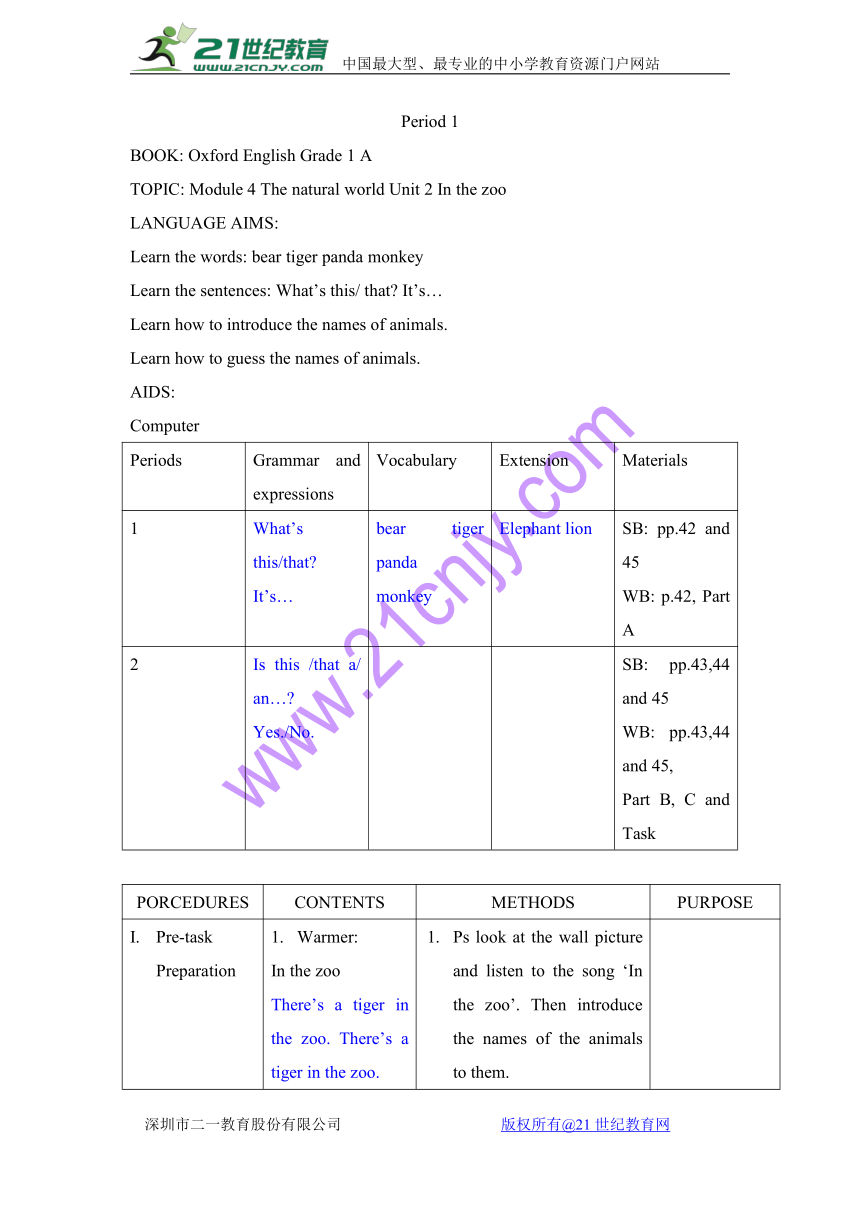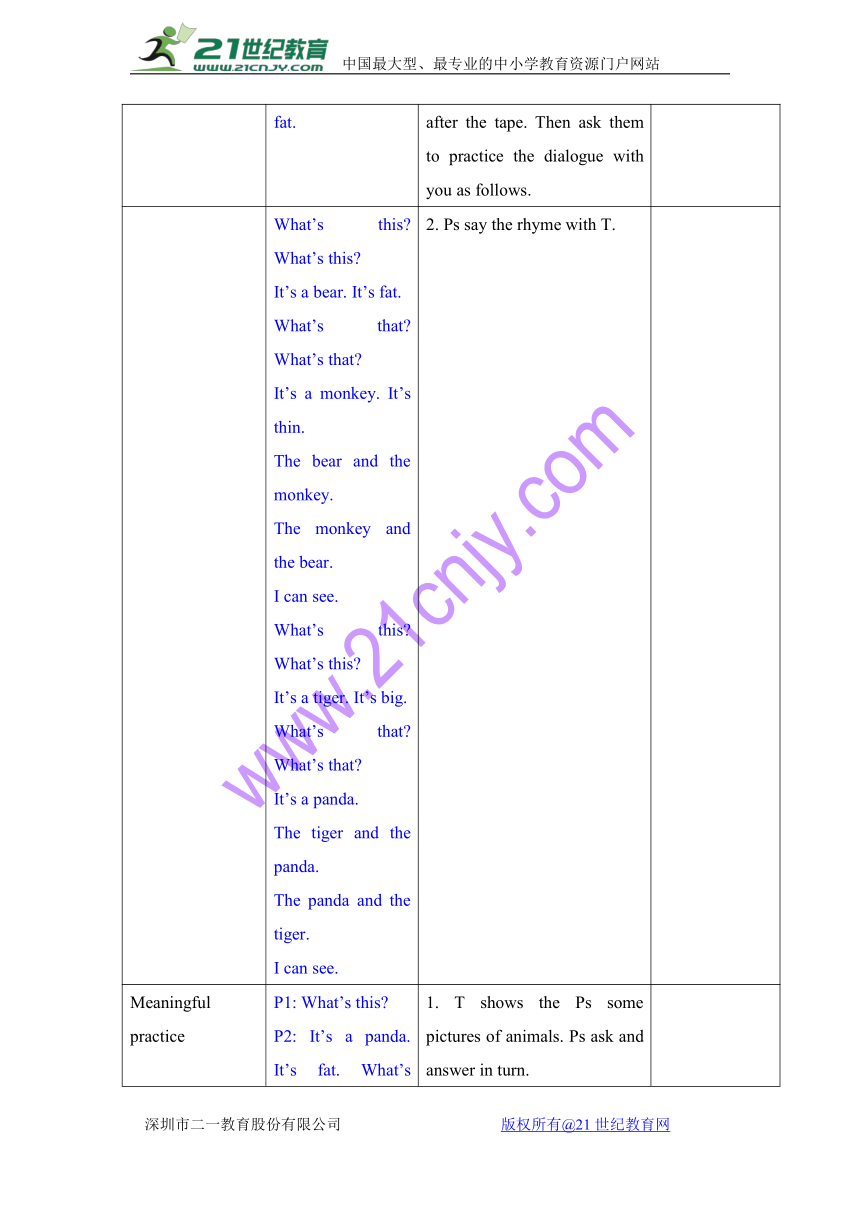Unit 11 In the zoo 教案
文档属性
| 名称 | Unit 11 In the zoo 教案 |

|
|
| 格式 | zip | ||
| 文件大小 | 121.6KB | ||
| 资源类型 | 教案 | ||
| 版本资源 | 牛津深圳版 | ||
| 科目 | 英语 | ||
| 更新时间 | 2017-12-09 19:13:12 | ||
图片预览



文档简介
Period 1
BOOK: Oxford English Grade 1 A
TOPIC: Module 4 The natural world Unit 2 In the zoowww.21-cn-jy.com
LANGUAGE AIMS:
Learn the words: bear tiger panda monkey
Learn the sentences: What’s this/ that? It’s…
Learn how to introduce the names of animals.
Learn how to guess the names of animals.
AIDS:
Computer
Periods
Grammar and expressions
Vocabulary
Extension
Materials
1
What’s this/that?
It’s…
bear tiger panda
monkey
Elephant lion
SB: pp.42 and 45
WB: p.42, Part A
2
Is this /that a/ an…?
Yes./No.
SB: pp.43,44 and 45
WB: pp.43,44 and 45,
Part B, C and Task
PORCEDURES
CONTENTS
METHODS
PURPOSE
Pre-task
Preparation
Warmer:
In the zoo
There’s a tiger in the zoo. There’s a tiger in the zoo.
There’s a tiger in the zoo. La la la la la la la.
There’s a lion in the zoo. There’s a lion in the zoo.
There’ a lion in the zoo. La la la la la la la.
There’s a monkey in the zoo. There’s a monkey in the zoo.
There’s a monkey in the zoo. La la la la la la la.
Ps look at the wall picture and listen to the song ‘In the zoo’. Then introduce the names of the animals to them.
T: Look! Here are the zoo animals. This is a bear. That’s a tiger. This is a panda. That’s a monkey.
2. Talk with Ps freely.
Lesson 2
While-task procedure
Elicition
Content 1: bear, monkey, panda, tiger
Mechanical practice
T: What’s that?
Pn: It’s a bear. It’s fat.
1. Ps listen to ‘Ask and answer’ on SB P42, and repeat after the tape. Then ask them to practice the dialogue with you as follows.
What’s this? What’s this?
It’s a bear. It’s fat.
What’s that? What’s that?
It’s a monkey. It’s thin.
The bear and the monkey.
The monkey and the bear.
I can see.
What’s this? What’s this?
It’s a tiger. It’s big.
What’s that? What’s that?
It’s a panda.
The tiger and the panda.
The panda and the tiger.
I can see.
2. Ps say the rhyme with T.
Meaningful practice
P1: What’s this?
P2: It’s a panda. It’s fat. What’s that?
P3: It’s a tiger. It’s big. What’s this?
1. T shows the Ps some pictures of animals. Ps ask and answer in turn.
P1: What’s this?
P2: It’s a panda. It’s fat.
P1: Yes. It’s a fat panda.
2. Ps do Part A ‘Listen and tick’ on WB P42. Ps ask and answer as follows.
Post-task activity:
P1: What’s this?
P2: (show the picture of an animal to him/her) It’s a panda. It’s black and white.
Ps make a short dialogue in pairs.
P1: Look! This is a monkey. It’s thin. It’s lovely. It can…
Ps introduce the animals they like in group.
Assignment
Listening: Listen to the tape on P42, P45 A
Speaking: Introduce an animal they like with classmates. B
Reading: Read the text on P42, P45 A
Recite the text on P42, P45 B
Lesson 3
BOOK: Oxford English Grade 1 A
TOPIC: Module 4 The natural world Unit 2 In the zoo21世纪教育网版权所有
LANGUAGE AIMS:
Learn the sentences: Is this/that a /an…? Yes. /No.21教育网
Learn how to obtain simple response. e.g. Is this a bear?21·cn·jy·com
Learn how to express confirm or deny.
AIDS:
Computer
PORCEDURES
CONTENTS
METHODS
PURPOSE
Pre-task
Preparation
Warmer:
e.g.
T: Is this a tiger?
Ps: Yes. /No.
T: What’s this? Is this a panda?
Ps: Yes. /No.
T flashes the pictures of the animals and ask the Ps to respond quickly.
T shows the Ps parts of toy animals. T ask the Ps to guess what animal it is.
While-task
Procedure
Content 1:
Is that a bear? Yes.
Is this a bear? No, it’s a panda.
Elicitation
1. Ps listens and repeat after the recording from SB P44.
Mechanical Practice
(T imitates panda’s motions and sounds)
T: Is this a tiger?
P2: No. It’s a panda.
T: Yes. It’s a panda.
2. T imitates animal’s motions and sounds and have Ps guess what the animal it is.
Meaningful Practice
P1 imitates tiger’s motions and sounds.
P1: Is this a monkey?
P2: No, it’s a tiger.
Group work:
One pupil imitates this animal. The others guess what the animal it is.
P1: Is this a bear?
P2: Yes, it’s a bear.
Ps play a passing game. They pass one toy animal and listen to the song from SB P45. When the music stops, the Ps who gets the toy animal stands up and asks a question. The others answer the question.
Lesson 4
Post-task activity:
P1: What’s this?
P2: Is this a monkey?
P1: Yes. Look! It’s thin.
P2: Oh, it’s a thin monkey.
Ps do Part B “Look, listen and answer” on WB P43.
Ps do Part C ‘Listen and play’ on WB P44.
Ps take out a toy animal to class. They do the ‘Play a guessing game’ on WB P45.
Assignment
Listening: Listen to the tape on P43, P44,P45 A
Speaking: Make a riddle and have other guess what the animal is. B
Reading: Read the text on P43, P44, P45 A
Recite the text on P43, P44, P45 B
板书:
Is this/that a /an…? Yes. /No.
教学反思:
本单元主要学习单词bear/tiger/monkey/panda和句型Is this a.../Is that a …在教学中设计了儿歌,单词记忆简笔画,形象直观,学生印象深刻,充分调动了学生的积极性,利用小组合作培养学生的学习协作能力。 一、通过“表演”激发学生的语言运用能力。在教新单词时,我采用一名学生在前面表演,结合课件让学习猜他在演什么动物,并用What’s this?提问。学生在看过表演后学习短语,让他们自己造句,激发学生语言的积极性,并提高了语言的运用能力。学生学习的热情很高,跃跃欲试,既活跃了课堂气氛,又增强了他们学习英语的兴趣。 二、通过“自学”培养学生的自信心。让学生听录音后自己模仿,并自己翻译意思。学生的能力得到了展现,信心也倍增,使他们有一种满足感。在这节课上利用了多煤体辅助教学,在教授过程中也有不足的地方,比如说,本节课在短语及句型的讲解中能运用体态语表现出来会更好,给学生更多的记忆空间,以后的教学中应该多注意。 21cnjy.com
BOOK: Oxford English Grade 1 A
TOPIC: Module 4 The natural world Unit 2 In the zoowww.21-cn-jy.com
LANGUAGE AIMS:
Learn the words: bear tiger panda monkey
Learn the sentences: What’s this/ that? It’s…
Learn how to introduce the names of animals.
Learn how to guess the names of animals.
AIDS:
Computer
Periods
Grammar and expressions
Vocabulary
Extension
Materials
1
What’s this/that?
It’s…
bear tiger panda
monkey
Elephant lion
SB: pp.42 and 45
WB: p.42, Part A
2
Is this /that a/ an…?
Yes./No.
SB: pp.43,44 and 45
WB: pp.43,44 and 45,
Part B, C and Task
PORCEDURES
CONTENTS
METHODS
PURPOSE
Pre-task
Preparation
Warmer:
In the zoo
There’s a tiger in the zoo. There’s a tiger in the zoo.
There’s a tiger in the zoo. La la la la la la la.
There’s a lion in the zoo. There’s a lion in the zoo.
There’ a lion in the zoo. La la la la la la la.
There’s a monkey in the zoo. There’s a monkey in the zoo.
There’s a monkey in the zoo. La la la la la la la.
Ps look at the wall picture and listen to the song ‘In the zoo’. Then introduce the names of the animals to them.
T: Look! Here are the zoo animals. This is a bear. That’s a tiger. This is a panda. That’s a monkey.
2. Talk with Ps freely.
Lesson 2
While-task procedure
Elicition
Content 1: bear, monkey, panda, tiger
Mechanical practice
T: What’s that?
Pn: It’s a bear. It’s fat.
1. Ps listen to ‘Ask and answer’ on SB P42, and repeat after the tape. Then ask them to practice the dialogue with you as follows.
What’s this? What’s this?
It’s a bear. It’s fat.
What’s that? What’s that?
It’s a monkey. It’s thin.
The bear and the monkey.
The monkey and the bear.
I can see.
What’s this? What’s this?
It’s a tiger. It’s big.
What’s that? What’s that?
It’s a panda.
The tiger and the panda.
The panda and the tiger.
I can see.
2. Ps say the rhyme with T.
Meaningful practice
P1: What’s this?
P2: It’s a panda. It’s fat. What’s that?
P3: It’s a tiger. It’s big. What’s this?
1. T shows the Ps some pictures of animals. Ps ask and answer in turn.
P1: What’s this?
P2: It’s a panda. It’s fat.
P1: Yes. It’s a fat panda.
2. Ps do Part A ‘Listen and tick’ on WB P42. Ps ask and answer as follows.
Post-task activity:
P1: What’s this?
P2: (show the picture of an animal to him/her) It’s a panda. It’s black and white.
Ps make a short dialogue in pairs.
P1: Look! This is a monkey. It’s thin. It’s lovely. It can…
Ps introduce the animals they like in group.
Assignment
Listening: Listen to the tape on P42, P45 A
Speaking: Introduce an animal they like with classmates. B
Reading: Read the text on P42, P45 A
Recite the text on P42, P45 B
Lesson 3
BOOK: Oxford English Grade 1 A
TOPIC: Module 4 The natural world Unit 2 In the zoo21世纪教育网版权所有
LANGUAGE AIMS:
Learn the sentences: Is this/that a /an…? Yes. /No.21教育网
Learn how to obtain simple response. e.g. Is this a bear?21·cn·jy·com
Learn how to express confirm or deny.
AIDS:
Computer
PORCEDURES
CONTENTS
METHODS
PURPOSE
Pre-task
Preparation
Warmer:
e.g.
T: Is this a tiger?
Ps: Yes. /No.
T: What’s this? Is this a panda?
Ps: Yes. /No.
T flashes the pictures of the animals and ask the Ps to respond quickly.
T shows the Ps parts of toy animals. T ask the Ps to guess what animal it is.
While-task
Procedure
Content 1:
Is that a bear? Yes.
Is this a bear? No, it’s a panda.
Elicitation
1. Ps listens and repeat after the recording from SB P44.
Mechanical Practice
(T imitates panda’s motions and sounds)
T: Is this a tiger?
P2: No. It’s a panda.
T: Yes. It’s a panda.
2. T imitates animal’s motions and sounds and have Ps guess what the animal it is.
Meaningful Practice
P1 imitates tiger’s motions and sounds.
P1: Is this a monkey?
P2: No, it’s a tiger.
Group work:
One pupil imitates this animal. The others guess what the animal it is.
P1: Is this a bear?
P2: Yes, it’s a bear.
Ps play a passing game. They pass one toy animal and listen to the song from SB P45. When the music stops, the Ps who gets the toy animal stands up and asks a question. The others answer the question.
Lesson 4
Post-task activity:
P1: What’s this?
P2: Is this a monkey?
P1: Yes. Look! It’s thin.
P2: Oh, it’s a thin monkey.
Ps do Part B “Look, listen and answer” on WB P43.
Ps do Part C ‘Listen and play’ on WB P44.
Ps take out a toy animal to class. They do the ‘Play a guessing game’ on WB P45.
Assignment
Listening: Listen to the tape on P43, P44,P45 A
Speaking: Make a riddle and have other guess what the animal is. B
Reading: Read the text on P43, P44, P45 A
Recite the text on P43, P44, P45 B
板书:
Is this/that a /an…? Yes. /No.
教学反思:
本单元主要学习单词bear/tiger/monkey/panda和句型Is this a.../Is that a …在教学中设计了儿歌,单词记忆简笔画,形象直观,学生印象深刻,充分调动了学生的积极性,利用小组合作培养学生的学习协作能力。 一、通过“表演”激发学生的语言运用能力。在教新单词时,我采用一名学生在前面表演,结合课件让学习猜他在演什么动物,并用What’s this?提问。学生在看过表演后学习短语,让他们自己造句,激发学生语言的积极性,并提高了语言的运用能力。学生学习的热情很高,跃跃欲试,既活跃了课堂气氛,又增强了他们学习英语的兴趣。 二、通过“自学”培养学生的自信心。让学生听录音后自己模仿,并自己翻译意思。学生的能力得到了展现,信心也倍增,使他们有一种满足感。在这节课上利用了多煤体辅助教学,在教授过程中也有不足的地方,比如说,本节课在短语及句型的讲解中能运用体态语表现出来会更好,给学生更多的记忆空间,以后的教学中应该多注意。 21cnjy.com
同课章节目录
- Module 1 Getting to know you
- Unit 1 Hello
- Unit 2 My classmates
- Unit 3 My face
- Revision 1
- Module 2 My family, my friends and me
- Unit 4 I can sing
- Unit 5 My family
- Unit 6 My friends
- Revision 2
- Module 3 Places and activities
- Unit 7 Let's count
- Unit 8 Apples, please
- Unit 9 May I have a pie?
- Revision 3
- Module 4 The world around us
- Unit 10 On the farm
- Unit 11 In the zoo
- Unit 12 In the park
- Revision 4
